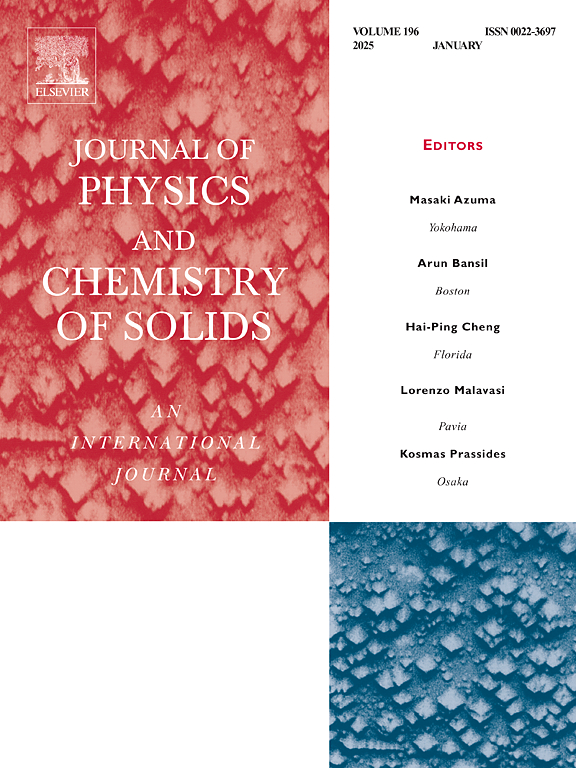Enhanced visible-light-driven photocatalytic performance of g-C3N4/BaTiO3 hybrids for efficient organic dye degradation
IF 4.9
3区 材料科学
Q2 CHEMISTRY, MULTIDISCIPLINARY
引用次数: 0
Abstract
Congo red (CR) dye, a known carcinogen present in wastewater, has been associated with bladder cancer, highlighting the urgent need for its effective and eco-friendly removal using non-toxic photocatalytic materials. This study investigates the structural, morphological, optical, elemental, specific surface area and visible-light-driven photocatalytic decolourizations of Congo red dye degradation behaviour of the g-C3N4/BaTiO3 hybrids were characterized. X-ray diffraction result confirmed phase purity and crystal structure of g-C3N4, BaTiO3, and g-C3N4/BaTiO3 hybrids. Scanning electron and Transmission electron microscopy images revealed a sheet-like morphology, nearly spherical and mixed morphology of g-C3N4, BaTiO3 and g-C3N4/BaTiO3, respectively. Ultra-violet diffuse reflectance spectral result indicated a blue shift in the absorption edge and a reduced band gap, suggesting enhanced visible-light absorption for the hybrid materials. X-ray photoelectron spectroscopy and energy dispersive X-ray spectroscopy results confirmed the element composition and oxidation states of C, N, Ba, Ti, and O elements. Brunauer–Emmett–Teller results revealed mesoporous structure of prepared samples. The g-C3N4/BaTiO3 hybrids exhibited higher efficiency (85 % degradation at 90 min) and a higher rate constant (0.011 min−1) under visible light. A potential degradation mechanism was proposed based on the surface area, pholuminescence, electronegativity and optical absorbance behavior. These results demonstrate that visible-light-active g-C3N4/BaTiO3 hybrids photocatalysts are highly promising for the efficient removal of Congo red model dye, offering a sustainable approach to reduce its carcinogenic effects.
g-C3N4/BaTiO3杂化物可见光催化降解有机染料性能的增强
刚果红(CR)染料是一种已知的致癌物质,存在于废水中,与膀胱癌有关,因此迫切需要使用无毒的光催化材料来有效和环保地去除其。本研究考察了g-C3N4/BaTiO3杂化物的结构、形态、光学、元素、比表面积和可见光驱动光催化脱色对刚果红染料的降解行为。x射线衍射结果证实了g-C3N4、BaTiO3和g-C3N4/BaTiO3杂化物的相纯度和晶体结构。扫描电镜和透射电镜图像显示g-C3N4、BaTiO3和g-C3N4/BaTiO3分别呈片状、近球形和混合形态。紫外漫反射光谱结果表明,杂化材料的吸收边蓝移,带隙减小,表明杂化材料对可见光的吸收增强。x射线光电子能谱和能量色散x射线能谱结果证实了C、N、Ba、Ti和O元素的元素组成和氧化态。brunauer - emmet - teller结果显示制备的样品具有介孔结构。g-C3N4/BaTiO3杂交种在可见光下表现出更高的降解效率(90 min降解85%)和更高的降解速率常数(0.011 min−1)。基于比表面积、发光性能、电负性和光吸收性能,提出了一种潜在的降解机理。这些结果表明,具有可见光活性的g-C3N4/BaTiO3杂化光催化剂在高效去除刚果红模型染料方面具有很大的前景,为减少其致癌作用提供了一种可持续的方法。
本文章由计算机程序翻译,如有差异,请以英文原文为准。
求助全文
约1分钟内获得全文
求助全文
来源期刊
CiteScore
7.80
自引率
2.50%
发文量
605
审稿时长
40 days
期刊介绍:
The Journal of Physics and Chemistry of Solids is a well-established international medium for publication of archival research in condensed matter and materials sciences. Areas of interest broadly include experimental and theoretical research on electronic, magnetic, spectroscopic and structural properties as well as the statistical mechanics and thermodynamics of materials. The focus is on gaining physical and chemical insight into the properties and potential applications of condensed matter systems.
Within the broad scope of the journal, beyond regular contributions, the editors have identified submissions in the following areas of physics and chemistry of solids to be of special current interest to the journal:
Low-dimensional systems
Exotic states of quantum electron matter including topological phases
Energy conversion and storage
Interfaces, nanoparticles and catalysts.

 求助内容:
求助内容: 应助结果提醒方式:
应助结果提醒方式:


